At present, biosensor research & development is increasing due to its many benefits like these are low-cost, rapid, and highly responsive. For developing innovative biosensors, interdisciplinary efforts are required beyond conventional specialties. So, a wide range of methods is used for the development of biosensors. This sensor is an extremely valuable device used to measure a wide spectrum of analytes like gases, organic compounds, ions & bacteria. This article discusses an overview of a biosensor – working with applications.
What is a Biosensor?
A sensor is used to measure biological or chemical reactions by simply generating signals which are proportional to the absorption of an analyte in the response. The short form of a biological sensor is biosensors. This sensor is designed with a transducer & a biological element like an enzyme, a nucleic acid/ an antibody.
In this sensor, a bio-element interacts with the analyte being checked & the biological reaction is changed into an electrical signal through the transducer. These sensors are called different names based on specific applications like immunosensors, resonant mirrors, optrodes, chemical canaries, glucometers, biocomputers & biochips. Biosensors are very helpful in monitoring disease, discovering of drugs, detecting pollutants, etc.
Biosensors Design
A biosensor is designed with different biosensor components like analyte, bioreceptor, transducer, electronics, and display. A typical biosensor diagram is shown below.
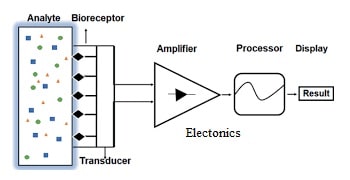
Biosensor Design
Analyte
The analyte is a substance of interest that requires detection. In biosensors, the best example of an analyte is “glucose” which is designed to detect glucose.
Bioreceptor
A bioreceptor is a molecule that particularly identifies the analyte. Examples of bioreceptor are; Enzymes, aptamers, cells, antibodies, and DNA (deoxyribonucleic acid). The procedure of signal generation on the bioreceptor interaction with the analyte is called bio-recognition.
Transducer
The transducer changes the energy from one form to another. The role of the transducer in biosensors is to change the bio-recognition result into an assessable signal. This energy conversion procedure is called signalization. Generally, transducers generate either electrical or optical signals that are generally proportional to the quantity of analyte–bioreceptor interactions.
Electronics
In biosensor, electronics is the part that simply processes the transduced signal & it displays on the display. It includes complex electronic circuitry that performs signal conditioning like amplification & signal conversion from analog form to digital. After that, the processed signals are quantified through the sensor’s display unit.
Display
The display unit mainly includes a user interpretation system like the LCD of a computer otherwise a printer that produces curves or numbers understandable by the consumer. This element frequently includes a combination of hardware & software that gives output in an accessible way. So, the output signal on the LCD can be graphic, numeric, tabular otherwise an image based on the necessities of the user.
Biosensor Working Principle
The working principle of biosensors is signal transduction, so it detects changes within Biological processes & changes them into an electrical signal. Therefore, a Biosensor is a combination of a transducer & Biological sensing element, which changes the data into electrical signals. In addition, there is an electronic circuit that includes a signal conditioning unit (SCU), a Microcontroller/ Processor & a display unit. Here, a biological process is any biological material or element such as enzymes, cells, microorganisms, tissues, acids, etc.
Biosensors Types
Biosensors are classified into different types which are discussed below.
Piezoelectric Sensor
These sensors are also called “Acoustic Biosensors” because they work on the sound vibrations principle. Once mechanical energy is applied to this biosensor, then they generate an electrical signal.
In this sensor, biological elements are connected to the outside of the sensor. This sensor is a mass (m) to frequency (f) converter that changes the mechanical vibrations of the detecting molecules to proportional electrical signals. An example of a piezoelectric sensor is nano balance or quartz crystal micro.
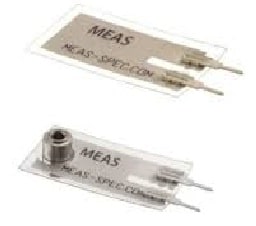
Piezoelectic Sensor
Electrochemical Sensor
This sensor has biological molecules which are covered onto a probing face. The molecules which need to be detected are held in position with a non-interfering membrane. After that, the detecting molecules appropriately respond to the compound to be detected & generate an electrical signal that is proportional to the amount being measured. These sensors use different transducers depending on their working principle like amperometric, impedimetric & potentiometric which changes chemical data into a measurable amperometric signal.
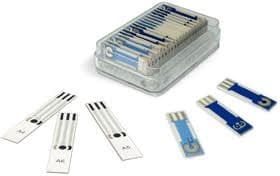
Electochemical Sensor
Optical Biosensor
In optical biosensors, optical fiber plays an essential role because these fibers simply allow detection of the sensing elements depending upon various properties of light such as absorption, scattering & fluorescence. This sensor is an analytical device that includes a bio-recognition detecting element that is incorporated with an optical transducer system.
The main function of this sensor is to generate a signal that is proportionate to the concentration of an analyte. This sensor uses different biological materials like antibodies, antigens, nucleic acids, receptors, tissues & whole cells as biorecognition elements.
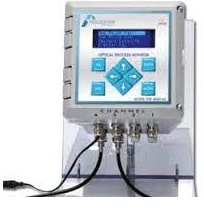
Optical Biosensor
These sensors provide many benefits over conventional analytical methods as they allow the real-time, label-free & direct detection of several chemical & biological substances. The advantages of this sensor mainly include small size, less cost, sensitivity, high specificity, etc. For implementing new optical biosensors, several advanced concepts are applied like microelectronics, MEMS (microelectromechanical systems), molecular biology, nano or micro technologies, biotechnology & chemistry.
Biosensor Interfacing with Microcontroller
The food we eat can get contaminated because of chemical changes or container used to store food or food not stored in the right temperature. Food contamination is caused by different viruses & bacteria so it leads to several food-borne diseases. So, it is significant to design a system that can assist people in recognizing food quality & freshness. This system uses electrical & biosensors, so biosensors play the main role in detecting bacterial contamination within a food sample. Based on these sensors output combinations, food quality can be detected.
The proposed system monitors the food using different sensors like humidity, temperature & light sensors. Once the temperature increases suddenly then it may enhance the risk of food spoiling. The increase in humidity may spoil some kinds of foods. Thus, the food threshold values are set in which the food stays unspoiled.
Other than humidity & temperature, light plays a significant role because lack of enough light to the food can cause it to destroy. So this system is used to check the levels of gas emitting from the food, once the food gets spoiled. The quantity of the gas level emitted from the food is simply checked throughout the gas sensors & changed into analog values to be shown on the platform of IoT to be checked wherever necessary.
Block Diagram
The following block diagram includes PSU (power supply unit), Wi-Fi modem, Arduino microcontroller, LDR, Gas sensor, DTH11 sensor & LCD.
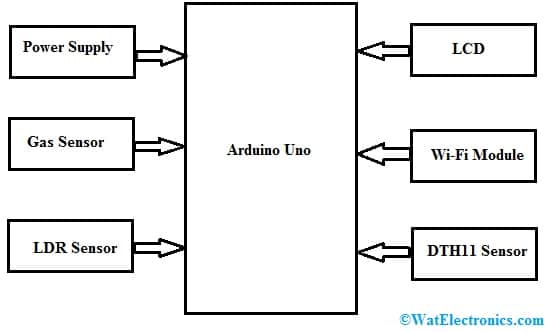
Biosensor Interfacing with Arduino
An open source microcontroller like an Arduino Uno board is based on the Microchip ATmega328P microcontroller. This microcontroller includes digital I/O pins – 14 where 6 are PWM outputs & 6 analog inputs, a USB connection, a 16 MHz – ceramic resonator, an ICSP header, a reset button & a power jack. So, it includes everything required to give support to the microcontroller; so it can easily connect to a computer through a USB cable otherwise powers it through a battery or an AC-to-DC adapter.
A gas sensor is an electrochemical sensor, used to measure the target gas concentration by simply reducing or oxidizing the gas at an electrode & measuring the resultant current.
The DHT11 is used as Temperature & humidity sensor. This sensor includes a dedicated NTC for measuring temperature & an 8-bit microcontroller to provide output temperature values as well as humidity-through a serial data.
The external wifi module used is ESP8266 with the typical AT Command set Firmware by simply connecting it to any type of microcontroller through the serial UART otherwise directly provide as a Wi-fi-enabled microcontroller.
LCDs are dominating LED displays because these types of displays are used to display numbers, alphabets & some type of special symbols, while LEDs like 7-segment displays can display simply numbers.
LDRs or Light Dependent Resistors are very useful, especially in light/dark sensor circuits. Normally the resistance of an LDR is very high, sometimes as high as 1,000,000 ohms, but when they are illuminated with light, the resistance drops dramatically.
Working
Here, a food quality monitoring system is designed to monitor different environmental factors such as humidity, temperature, and exposure to light & alcohol content. This device is built on Arduino UNO.
This is an IoT device, used to transmit the measured data of the sensor to an IoT stage. The ESP8266 is interfaced to the Arduino to connect it to the internet through a Wi-Fi router. So, the sensor data is simply shown on a character LCD connected by the Arduino UNO.
So by using IoT, the environmental factors which will affect the storage of food can be simply monitored at any time, anywhere from any device. This system must be installed within a food store. When this system is installed properly & turned ON, then it connects to the internet through a Wi-Fi modem & starts reading sensor data. It transmits a real-time humidity & temperature reading every two seconds. The IoT is mainly used for monitoring & logging sensor data.
So the sensor works with a 3.5 – 5.5 V supply & it can read temperature from 0° C to 50° C & relative humidity is 20% & 95%. The Arduino board collects all the sensor data & converts these values into strings. So, the sensor data is covered as suitable strings and transmitted to display on the character LCD. The ESP8266 Wi-Fi module which is connected to the Arduino board simply uploads the sensor data to the embedded spot Server.
Biosensors Characteristics
The characteristics of biosensors are selectivity, reproducibility, stability, sensitivity, and linearity which are discussed below.
- The most significant feature of this sensor is selectivity and it is the capability of a bioreceptor to sense a particular analyte within a sample that contains other contaminants & admixtures.
- Reproducibility is the capability of the biosensor to produce identical responses for a duplicated experimental system.
- The Stability is the amount of susceptibility to ambient troubles in & around the bio sensing system.
- The minimum quantity of analyte that is sensed by a biosensor to define its sensitivity or limit of detection.
- The attribute like linearity shows the precision of the measured response to a straight line, so mathematically it is denoted y = mc, where ‘c’ is the analyte’s concentration, ‘y’ is the o/p signal & ‘m’ is the biosensor’s sensitivity.
Advantages and Disadvantages
The advantages of biosensors include the following.
- It has rapid & continuous measurement.
- For calibration of this sensor, very less reagents are required.
- Its response time is fast.
- It is capable of measuring non-polar molecules where these molecules cannot be predictable through other conventional devices.
- Biosensor easily detects dangerous biological agents or chemicals within the human body.
- This sensor can change the signal from biological to electronic or electrical that can be simply measured, amplified & quantified.
- This sensor simply works by using a particular biochemical reaction, so there is no more difficulty in the sensor working.
- This technology is not very much expensive, so its usage day by day is increasing.
- These are extremely precise for the analyte.
- The size of these sensors is very small.
- These are biocompatible & very reliable.
The disadvantages of biosensors include the following.
These are relatively poor sensitivity for many of the clinically related targets & semi-quantitative or qualitative results. To enhance the detection limit, the latest efforts have focused on the amplification of the signal.
Applications
The applications of biosensors include the following.
- These are used for testing purposes in the medical industry.
- This kind of sensor is used to detect pathogens.
- These are used for water treatment & environmental monitoring like detection or tracing of gas.
- This sensor is used to detect toxic metabolites.
- This sensor is used to recognize the contaminants within water like heavy metal ions.
- These are applicable in biodefense technology & security system.
- Blood Glucose type biosensor is useful for monitoring glucose in the human body.
- It is used for cholesterol testing, vitamins, folic acid & biotin measurements.
- These are used in Agriculture and Biotech industries for monitoring different kinds of chemical and their properties within a particular system continuously.
- Biosensors are used for determining the antibiotics, pesticides, vitamins B complex, proteins & fatty acids levels found in foods.
Know More about Optical Sensor.
Thus, Biosensors are bio-analytical systems used for detecting biological samples. These sensors are powerful devices, available in small size & capable of biological samples analyzing to recognize their structure, composition, and function. So this is attained by changing a biological signal that otherwise responds to a computable response. Here is a question for you, what is the biometric sensor? To know m0re like on the link biosensor.